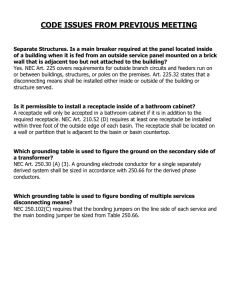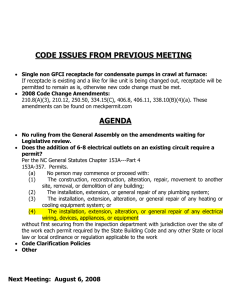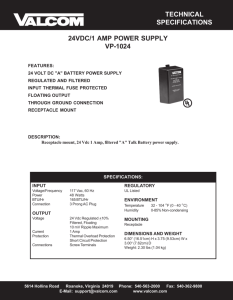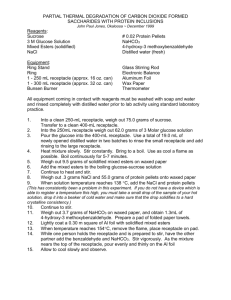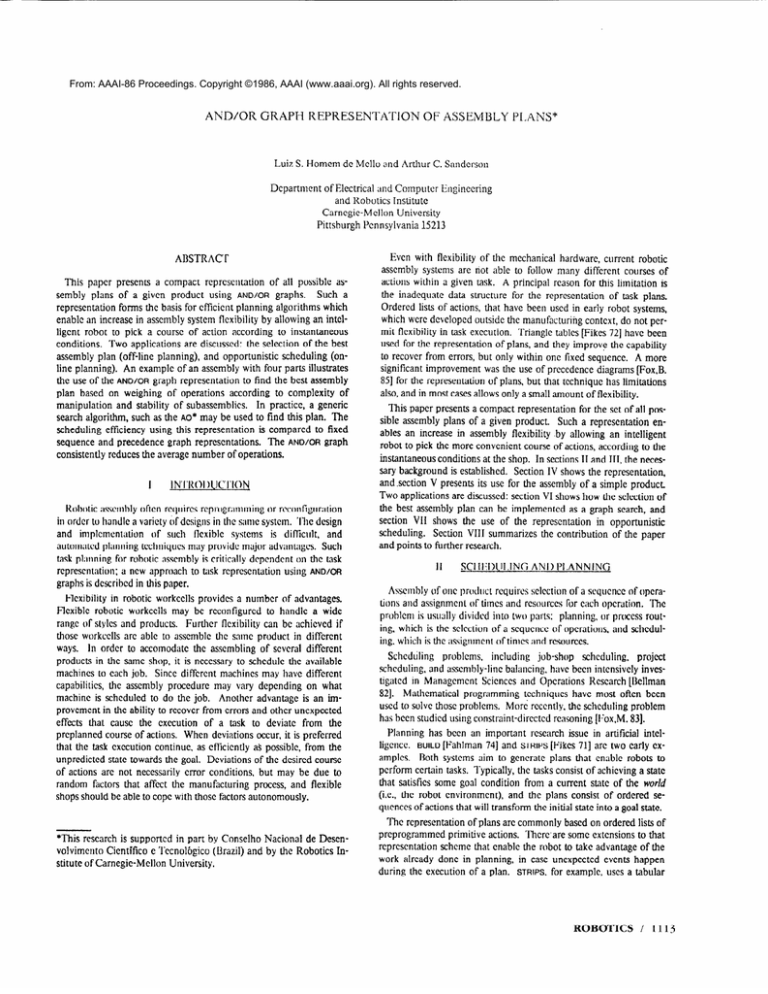
From: AAAI-86 Proceedings. Copyright ©1986, AAAI (www.aaai.org). All rights reserved.
AND/OR
GRAPH
REPRESENTATION
OF ASSEMBLY
PI.ANS*
Luiz S. Momcm dc Mcllo and Arthur C. Sandcrson
Department of Electrical and Computer Engineering
and Robotics Institute
Carnegie-Mellon University
Pittsburgh Pennsylvania 15213
ABSTRAC’f
This paper presents a compact representation of all possible assembly plans of a given product using AND/OR graphs. Such a
representation forms the basis for efficient planning algorithms which
enable an increase in assembly system flexibility by allowing an intclligcnt robot to pick a course of action according to instantaneous
conditions, Two applications are discussed: the selection of the best
assembly plan (off-line planning), and opportunistic scheduling (online planning). An example of an assembly with four parts illustrates
the use of the AND/OR
graph representation to find the best assembly
plan based on weighing of operations according to complexity of
manipulation and stability of subassemblies. In practice, a generic
search algorithm, such as the AO* may be used to find this plan. The
scheduling efficiency using this representation is compared to fixed
sequence and precedence graph reprcscntations. The AND/OR graph
consistently reduces the average number of operations.
I
IN’l’liOl )l.Jc”l’lON
Robotic as3crnbly often rcquircs reprogramming or reconfiguration
in order to handle a variety of designs in the s;nnc system. ‘I’hcdesign
and implcmcntation of such flcxiblc systems is diflicult, and
automated planning tcchniqucs may provide major advantages. Such
task pkmning for robotic assembly is critically dcpcndcnt on the task
rcprescntation; a new approach to task rcprcscntation using AND/OR
graphs is dcscribcd in this paper.
Flexibility in robotic workcells provides a number of advantages,
Flcxiblc robotic workcclls may bc rcconfigurcd to hnndlc a wide
range of styles and products. Further flexibility can bc achieved if
those workcclls arc able to asscmblc the same product in diffcrcnt
ways. In order to accomodatc the assembling of scvcral diffcrcnt
products in the same shop, it is ncccssary to schcdulc the available
machines to each job. Since diffcrcnt machines may have diffcrcnt
capabilities, the assembly procedure may vary depending on what
machine is schcdulcd to do the job, Another advantage is an improvement in the ability to recover from errors and other unexpected
effects that cause the cxccution of a task to deviate from the
prcplanncd course of actions. When deviations occur, it is preferred
that the task cxccution continue, as effrcicntly aS possible, from the
unpredicted state towards the goal. Deviations of the desired course
of actions arc not necessarily error conditions, but may be due to
random factors that affect the manufacturing process, and flexible
shops should be able to cope with those factors autonomously.
*This research is supported in part by Conselho National de Descnvolvimcnto Cientifico e ‘I’ccnolbgico (Brazil) and by the Robotics Institute of Carnegie-Mellon University.
Even with flexibility of the mechanical hardware, current robotic
assembly systems are not able to follow many different courses of
actions within a given task. A principal reason for this limitation is
the inadequate data structure for the representation of task plans.
Ordered lists of actions, that have been used in early robot systems,
which wcrc dcvcloped outside the manufacturing context, do not permit flexibility in task execution. Triangle tables [Fikes 721have been
used for the representation of plans, and they improve the capability
to recover from errors, but only within one fixed sequence. A more
significant improvement was the use of precedence diagrams [Fox.B.
851for the representation of plans, but that technique has limitations
also, and in most cases allows only a small amount of flexibility.
This paper presents a compact representation for the set of all possible assembly plans of a given product. Such a representation enables an increase in assembly flexibility .by allowing an intelligent
robot to pick the more convenient course of actions, according to the
instantaneous conditions at the shop. In sections II and III, the necessary background is established. Section IV shows the representation,
andsection V presents its use for the assembly of a simple product,
Two applications are discussed: section VI shows how the selection of
the best assembly plan can be implemented as a graph search, and
section VII shows the use of the representation in opportunistic
scheduling. Section VIII summarizes the contribution of the paper
and points to further research.
II
SCIIl~I>I.II.lNG ANI) I’lANNING
hsscnibly of one prodrlcl rcquircs sclcction of a scqucncc of opcralions and assignment of times and resources for each operation. The
problcnt is usucrllydivided into two Ixtrts: planning, or process routing. which is the sclcction of a scqucncc of operations, and schcduling. which is the assignment of times and rcsourecs.
Schcdtiling problems, including job-shop scheduling, projcet
scheduling, and assembly-line balancing, have been intcnsivcly investigatcd in Management Scicnccs and Operations Rcscarch [Bellman
821. Mathematical programming tcchniqucs have most often been
used to solve those problems. Mord rcccntly, the scheduling problem
has been studied using constraint-dircctcd reasoning [t:ox,M. 831.
Planning has been an important research issue in artificial intclligc~xc. BUILD [Fahlman 741 and STRIPS [Fikcs 711 arc two early cxamplcs. Both systems aim to gcncrate plans that cnablc robots to
perform certain tasks. Typically, the tasks consist of achieving a state
that satisfies some goal condition from a current state of the world
(i.e., the robot cnvironmcnt), and the plans consist of order-cd sequcnccs of actions that will transform the initial state into a goal state.
The representation of plans arc commonly based on ordered lists of
preprogrammed primitive actions. Thcrcare some extensions to that
reprcscntation scheme that cnablc the robot to take advantage of the
work already done in planning, in cast unexpected events happen
during the execution of a plan. STRIPS, for example, uses a tabular
ROBOTICS
/ 1113
form, called a triangle Iable, to store a plan. BUILD associates to each
primitive action a REASON list (subgoals) as well as a description of the
states of the world bcforc and after the action is executed. More
recent systems, ‘such as NOAH [Sacerdoti 771, represent plans as partially ordered sequences of actions with respect to time.
A major emphasis of research on planning has been on the search
aspect of the problem, especially control schemes for the search.
Priority has been given to develop efficient, powerful and general
purpose procedures that can find at lcast one plan in a wide variety of
situations rather than procedures that eventually find the most efficient plan in a more restricted type of situation. In applications
where plans are executed one time only, inefficiencies in the plan do
not cause any major harm. Also, if plans are generated on line, high
speed in plan generationis often preferable to optimal plans.
Search for the most efficient plan requires a criterion to decide
whether one plan is better than another. This decision, however,
usually requires information available at execution time only, and
producing the plan in real time may degrade the robot operation, or
even be unfeasible, due to the long computing time it usually takes to
generate a plan. The choice between planning ahead of time (off line)
and planning in real time (on line) is difficult; the former may lead to
inefficient plans, whereas the latter may cause a degradation in the
robot operation.
111
PLANNING FOR ROBOTIC ASSEMBLY
To achieve the desired high levels of productivity, the assembly
plans must be efficient and keep wasted time and resources to a minimum. Should inefflciencics in the assembly plan of one product be
multiplied by the size of the lot, which in common robotic assembly
applications ranges from 1,000 to 100,000 units, the resulting total
waste may reduce drastically the productivity and may jeopardize the
whole process. Conditions at the shop, however, change with time
(for example, parts may come in random order), and-usually, there is
no single plan that is efficient in every possible situation.
Fox and Kempf [Fox,B. 851 address the need to act opportunistically, as opposed to always follow a preprogrammed fixed order of
operations. They suggest that plans gencratcd off-line to be given to
the robot be a set of operations with minimal ordering constraints.
Such a plan was represented by a precedence diagram and would
actually encompass several possible sequences of operations that
would peiform the task of assembling a given product. In real time,
depending on the conditions at the shop, the intelligent robot would
pick the most appropriate sequence. Using Fox and Kempf notation,
the selection of one sequence, and the assignment of operations to
specific machines is what is commonly referred to as the scheduling
process. Since that selection process involves much less computing
time than the planning process, no degradation in the efficiency of the
robot operation should occur.
Planning, in this sense, should yield all possible sequences of operations that can be used to assemble a product. That information is the
input to the scheduling process, which in real time selects one of those
sequences and assigns the machines that will do each operation.
The problem with the precedence diagram formalism, as Fox and
Kempf themselves point out, is that for most products no single partial order can encompass every possible assembly sequence. The assembly of the simple product shown in exploded view in figure 1, for
example, may be completed by following one of the ten different
sequences of operations that are represented graphically in figure 2. It
is possible to combine some sequences into one partial order using
precedence diagrams. Figure 3 shows three possible ways to combine
two of the first four sequences in figure 2; the only restriction is that
the insertion of the stick cannot be the last operation. It is possible to
combine three of those four sequences into one partial order by using
1114
/ ENGINEERING
a dummy operation, but it is not possible to combine the four sequences into one partial order, nor it is possible to combine any of
those sequences with the other six sequences in figure 2.
A closer look at the partial ordering representation of plans, in the
light of the above assembly example, shows another deficiency of that
solution. Two distinct feasible sequences, A-B-C and B-A-C, for example, do not differ simply by the sequence of the operations. Inserting the stick first is not the same operation as inserting it after the
receptacle and the cap have been screwed together. The latter operation is probably easier to execute. Similarly, screwing the receptacle
and the handle with the stick inside is probably easier to do if the
receptacle and the cap are screwed, than otherwise. The partial ordering approach, howcvcr, does not capture this subtle difference. The
next section will describe another approach to the representation of
plans that captures this difference, and that can combine all possible
assembly sequences.
IV
ANlWOR GRAtW I~l’i’lillSf~N’I’/\‘I’IC)N
01: ASSI’M 131,Y
PI ANS
Planning the assembly of one product made up of scvcral componcnt parts can be seen as path search in the state space of all pos-
sible configurations of that set of parts. The initial state is that configuration in which all parts arc disconncctcd from each other. and the
goal state is that in which the part! arc properly joined to form the
desired product l’hc moves that change one sratc into another correspond to the assembly operations since they change the relative
position of at Icast one part. ‘I’hcre may bc many din’crcnt paths from
the initial state to the goal state. Krogh and Sandcrson [Krogh 851
present an ovcrvicw of task decomposition and operations.
In this context, any set of parts that arc joined to form a stable unit
is called an assembly. A component part is also an assembly, with a
special property. The word subassembly rcfcrs to an assembly that is
part ofi another, more complex assembly, and it always carries the
subs&./set connotation.
Because there are many configurations that can bc made from the
same parts, the branching factor from the initial state to the goal state
is greater than the branching factor from the goal state to the initial
state. A backward search, thcrcfore, will be more efficient than a
forward search for the assembly planning problem. The problem of
finding how to assemble a given product can bc converted to an
equivalent problem of finding how the same product can be
disassembled. Since assembly operations are not ncccssarily revcrsiblc, the equivalence of the two problems will hold only if each operation used in disassembly is the reverse of a feasible assembly operation, regardless of whether these reverse operations themselves are
feasible or not. The expression disassembly operation, therefore, refers
to the reverse of a feasible assembly operation.
The backward search suggests a decomposable production system in
which the problem of disassembling one product is decomposed into
distinct subproblems, each one being to disassemble one subassembly.
Each decomposition must correspond to a disassembly operafion. If
solutions for both subproblems that result from the decomposition are
found, then a solution for the original problem can be obtained by
combining the solutions to the subproblems and the operation used in
the decomposition. For subassemblies that contain one part only, a
trivial solution containing no operation always exists. Usually there
will not be a unique way to decompose the problem, or to cuf the
assembly, because there may be several different ways to assemble the
same product,
A
B
C
B
SCREW
RECEPTACLE
STICK
INTO
RECEPTACLE
HANDLE
RECEPTACLE
STICK
CAP
Figure 1: A simple product
B
A
v
C
RECEPTACLE
SCREW
RECEPTACLE
AND HANDLE
A
c
El
AND CAP
B
B
SCREW
RECEPTACLE
ANDCAP
INSERT
STICK INTO
RECEPTACLE
SCREW
RECEPTACLE
INSERT
INSERT
STICK INTO
v
STICK INTO
RECEPTACLE
v
(2)
B
v
RECEPTACLE
c
c
v
v
A
SCREW
RECEPTACLE
AND HANDLE
SCREW
RECEPTACLE
AND HANDLE
(A-B-C)
(B-A-C)
n
v
SCREW
RECEPTACLE
AND CAP
c
v
SCREW
RECEPTACLE
AND HANDLE
c
v
AND CAP
\’
SCREW
RECEPTACLE
AND CAP
(EGA)
(8)
A
A
L
v
SCREW
RECEPTACLE
AND CAP
(C-D-A)
m
v
SCREW
RECEPTACLE
AND CAP
E
v
v
PLACE
STICK
ON HANDLE
SCREW
RECEPTACLE
AND CAP
c
v
PLACE
STICK
ON CAP
A
PLACE
STICK
ON HANDLE
STICK
ON HANDLE
v
D
(6)
E
SCREW
RECEPTACLE
AND HANDLE
SCREW
RECEPTACLE
AND HANDLE
(D-C-A)
PLACE
A
v
SCREW
RECEPTACLE
(5)
c
(4)
SCREW
RECEPTACLE
AND HANDLE
A
(3)
Figure 3: Precedence diagrams: (I) combines A-B-C and B-A-C;
(2) combines C-B-A and B-A-C; (‘3)combines B-A-C and R-C-A
c
PLACE
STICK
ON CAP
(D-A-C)
E
(C-B-A)
(3)
D
ON CAP
RECEPTACLE
v
SCREW
RECEPTACLE
AND CAP
(B-C-A)
PLACE
STICK
A
A
v
SCREW
RECEPTACLE
AND CAP
(2)
(1)
,
INSERT
STICK INTO
RECEPTACLE
SCREW
RECEPTACLE
AND HANDLE
SCREW
RECEPTACLE
AND CAP
INSERT
STICK INTO
RYCEPTACLE
L
RECEPTACLE
AND tlhNI>LE
c
v
SCREW
RECEPTACLE
AND IiANDLE
SCREW
RECEPTACLE
AND HANDLE
(E-A-C)
(A-E-C)
(9)
W)
Structures called AND/OR graphs [Nilsson 801, or Izypergraphs, are
uscfi~l in representing dccomposablc problems and they have been
used to represent the disassembly problem. The nodes in such a hypergraph correspond to assemblies; nodes corresponding to assemblies that contain only one part are the terminal nodes. The hyperarcs (or k-connectors, k being any integer greater than zero) correspond to the disassembly operalions. Each hyperarc that leaves one
node corresponds to a disassembly operarion applicable to the assembly of that node, and the successor nodes to which the hyperarc
points correspond to the resulting subassemblies produced by the
disassembly operation.
Because for most products the assembly
operations usually mate two subassemblies, the hyperarcs in the corresponding AND/OR graph are usually 2-connectors. There are cases,
however, of operations that mate more than two subassemblies (e.g.,
assembling a hinge with two wings and one pin), as well as operations
that involve only one subassembly (e.g., drilling a hole in a part).
Hyperarcs in AND/OR graphs can represent all those possibilities.
A solurion tree from a node N in an AND/OR graph is a subgraph
that may be defined recursively as either N itself if N is a terminal
node, or N plus one of its outgoing hyperarcs plus the set of solution
trees from each of N’s successors through that hyperarc. This definition assumes that the graph contains no cycle 4s is true in the
disassembly problem. There may be none, one, or several solution
trees from a node in an AND/OR graph.
The useful feature of the AND/OR graph representation for the asscmbly problem is that it encompasses all possible partial orderings of
assembly operations. Moreover, each partial order corresponds to a
solution tree from the node corresponding to the final (assembled)
product. This feature is demonstrated through the example in the
next section.
Figure 2: Possible scqucnccs of operations to asscmblc the product
shown in figure 1
ROBOTICS
/
1115
Figure 4:
v
AND/OR
graph for the product shown in figure 1
A SIMPLE EXAMPLE
Figure 4 shows the AND/OR graph for the product in figure 1. Each
node in that graph is labeled by a database that correponds to an
assembly. In flgurc 4, the databases are represcntcd by exploded view
drawings, whereas in a computational implementation, the databases
are relational data structures. To facilitate the exposition, both the
nodes and the hyperarcs in figure 4 have idcntiflcation numbers.
1116
/ ENGINEERING
The root node in figure 4 (node 1) is labclcd by a database that
describes the assembled product. There are four hyperarcs leaving
that node. Each of those four hyperarcs corresponds to one way the
whole assembly can be disassembled and each one points to two nodes
that are labeled by databases that describe the resulting subassemblies. Similarly, the other nodes in the graph have a leaving
hyperarc for each possible way in which their corresponding subassembly can be disassembled.
Figure 5: Solution tree corresponding to sequence 4 in fig 2
Figure 7: Solution tree corresponding to sequence 1 in fig 2
Any subassembly that can be made up of the component parts may
appear only once in the graph, even when it may be the result of
different disassembly operations. The subassembly of node 4, in
figure 4, for example, may result From two different operations, which
correspond to hyperarcs 5 and 10. Moreover, those two hyperarcs
come from two distinct nodes. Nodes corresponding to component
parts (nodes 9,10,11 and 12) are the terminal or goal nodes since they
correspond to disassembling problems for which a (trivial) solution is
known.
There are eight solution trees from the root node (node 1) and three
of them are shown in figures 5 to 7. One important feature of the
solution tree representation is that the distinction between operations
becomes apparent because distinct operations correspond to distinct
hyperarcs. In other words, two distinct assembly sequences include
the same operation only if the two corresponding solution trees include the hyperarc corresponding to that operation. The sequence
diagrams in figure 2 and the prccedcnce diagrams in figure 3 fail to
make this distinction. The solution tree shown in figure 6 corresponds
to two sequences, but unlike the precedence diagrams of figure 3, the
operations are exactly the same, regardless of the order in which they
are executed.
Figure 6: Solution tree corresponding to sequences 6 and 7 in fig 2
To solve problems that require optimization, such as the sclcction of
the best assembly plan, one must bc able to travcrsc the space of all
candidate solutions, rcgardlcss of the method used to solve the
problem. The choice of the rcprcscntation is critical since it is or\en
difficult it) delimit the set of potential solutions in a form which
cnumcratcs all the clcmcnts.
ROBOTICS
/ 1117
The AND/OR graph rcprcscntation encompasses all possible ways to
assemble one product, and thcrcfore allows one to cxplorc the space
of all possible plans. Since plans correspond to solution trees in the
AND/OR graph, the sclcction of the best plan can be seen as a search
problem. Any such search problem rcquircs a criterion to compare
plans. One possibility is to assign to the hyperarcs weights proportional to the difficulty of their corresponding operations, and then
compute the cost of a solution tree from a node, recursively, as:
l zero, if the node has no leaving hypcrarc; or
l the sum of the weight of the hypcrarc leaving the node
and the costs of the solution trees from the successor
nodes.
The best plan corresponds to the solution tree that has the minimum
cost. The search for the best plan can be conducted using generic
algorithms such as the AO* [Nilsson 801.
A variety of factors might be considered in assigning weights to
hypcrarcs, including time duration of their corresponding operations,
requirements for reorientation of fixturing, cost of resources needed,
reliability, as well as production priorities and constraints.
For the product in figure 1, the AND/OR graph (figure 4) has 15
hyperarcs, which correspond to 15 different assembly operations.
Table 1 shows one possible assignment of weights to hyperarcs.
Those weights have been computed by adding two factors. The first
factor is the type of assembly operation, with screw operation weighing 4, insertion 2 and placement 1, in accord with typical time, fixturing and manipulation requirements. The second factor taken into
account is the difficulty of handling the participating subassemblies,
and is proportional to their number of degrees of freedom; subassemblies with more degrees of freedom are more unstable, and
therefore more difficult TVhandle. Using that assignment of weights
to hyperarcs, the total cost for the solution trees can be computed.
The solution trees in figures 5 and 7 have the minimum cost of 11.
For. more complex assemblies, instead of a complete enumeration as
suggested above, search algorithms can be used to reduce computation. For the product in figure 1, a search using AO* will yield one of
the solution trees shown in figures 5 or 7, depending on how the
partial solutions and tip nodes are ordered for expansion.
Table 1: Assignment of weights to hypcrarcs
hypcrarc
1118
operation
type
subassemblies
degrees of
freedom
total
weight
1
4
1
5
2
4
4
8
3
4
4
8
4
4
1
5
5
4
2
6
6
4
4
8
7
2
0
2
2
8
2
0
9
4
4
8
10
4
2
6
11
2
0
2
12
1
0
1
13
4
0
4
14
4
0
4
15
1
0
1
/ ENGINEERING
VlI
Ol’1’OI~‘I’~JNlS’l’lC
SCI11’1)1ll.l 1N(; (ISING THF;
ANl)/Oli GKAI’I I IZlil’l(l’SIIN’I’A’I’lON
To evaluate how the USCof AND/OR graph reprcscntation for assembly plans afl’ccts assembly cflicicncy. a comparntivc analysis
among the three rcprcscntation schcmcs discussed in this paper has
been conducted.
The product in flgurc 1, and the robot workstation of figure 8 have
been used as cxamplcs. The workstation is cquippcd with two
manipulators and the parts arc prcscnted in random order. It is assumcd that a cap, a stick, a rcceptaclc, and a handle always come
together, varying only in their order. It is also assumed that both
manipulators arc controlled by the same central unit and they both
arc able to execute the following actions:
l acouire: fetching, by one of the manipulators, of one part
from the part feeder
l buffer: temporarily storing one part into a fixed location
within the workstation
l w:
joining two subassemblies which are currently held
by the manipulators
l rctrievc: fetching, by one of the manipulators, one part
known to be in the parts buffer
The efficiency of this assembly station depends on the capacity to
handle parts in random order. This requires on-lint scheduling of
system resources dcpcnding on the order of parts arrival. The relative
impact of plan representation schemes on assembly efficiency can be
compared by the average number of operations needed: a smaller
average number of operations corresponds to more efficiency.
The first sequence of figure 2 (A-B-C) has been used as an example
of fixed sequence reprcscntation and the first prcccdcncc diagram of
figure 3 (combines A-B-C and B-A-C) as an example of precedence
graph representation. Similar results will be produced using the other
fixed sequences or precedence graphs. The number of operations that
would be performed for each of the 24 possible orderings in which the
four parts of the simple product can be acquired is shown in Table 2.
At least 7 operations are necessary: four acquisitions and three
matings; depending on the order in which the parts are presented,
buffering, and therefore retrieving may also be necessary.
When using the fixed sequence representation of plans, extensive
buffering is necessary. For example, if the order the parts come is R H
s c (receptacle, handle, stick, and cap) both the handle and the stick
must be buffered since they are not used in the first operation; adding
two bufferings and two retrievings to the four acquisitions and three
matings that are always necessary yields 11 operations. The average
number of operations for all 24 possible orders is 9.8.
Using precedence diagrams for the representation of plans avoids
some of the buffering and reduces the average number of operations
to 9.2. For the sequence R H s c, for example, only the handle must be
buffered since the insertion of the stick into the receptacle may be the
first operation.
Using the AND-OR graph representation of plans, however, avoids
most of the buffering, and yields the average of 8 operations. For the
same R H s c sequence, for example, no buffering is necdcd because
the robot can follow the sequence of operations corresponding to the
solution tree shown in figure 5.
VIII
CONCLUSION
A compact representation for the set of all possible assembly plans
of a product has been presented, along with its applications in me
selection of the best assembly plan and in opportunistic scheduling.
One important feature of that representation is that it allows one to
Table 2: Number of operations needed to assemble the product of
fig 1 for all the sequences in which the parts may be acquired,
and for the three schemes of plan representation
C = cap S = stick R = receptacle H = handle
first sequence
in fig2
first precedence
diagram in fig 3
CSRH
9
9
7
9
sequence
graph
fig4
AND/OR
CSHR
11
11
CRSH
7
7
7
CRHS
9
9
9
CHSR
11
11
9
CHRS
9
9
9
SCRH
9
9
7
SCHR
11
11
9
SRCH
9
7
7
SRHC
11
9
7
I I
I
11
11
9
11
9
7
RCSH
7
7
7
RCHS
9
9
9
Maihematical Aspects
Applications.
RSCH
9
7
7
Pergamon Press, 1982.
11
9
7
9
9
9
RHSC
11
9
7
HCSR
11
11
9
HCRS
9
9
9
HSCR
11
11
9
HSRC
11
9
7
HRCS
9
9
9
HRSC
11
9
7
average
9.8
9.2
8
traverse the space of all possible assembly plans, and theretore
provides an opportunity to select an optimal schedule and dynamically adapt scheduling to changing conditions. Both the fixed sequence representation and the precedence diagram representation are
very limited in this aspect.
A number of issues related to this representation are under investigation. One important issue is the development of algorithms for
opportunistic scheduling suitable for real time operation. As pointed
out in section VII, some buffering could not be avoided, even with the
use of AND/OR graph representation of plans. For complex products,
the choice of which part or subassembly to buffer may affect the
overall assembly efficiency and criteria for that decision will be necessary. These criteria will certainly depend on evaluation fimctions, also
under investigation, used to select a plan, especially functions that do
not possess the recursive property like the one used in section VI.
An additional important ongoing research issue is the development
of a representation of assemblies suitable for the automatic generation
of plans. Such automation can be helpfil in design of both new
products and assembly systems. In designing new products, the desig
ner can quickly assess the difficulty of assembling and eventually
1
modify the design to facilitate the assembly. In designing new assembly systems, the designer can evaluate the performance of a
proposed design for a given set of products.
SHCR
RSHC
BUFFER
Figure 8: Robotic workstation
SHRC
RHCS
MANlPULAToRS
REFERENCES
[Bellman 821
Bellman, R. et al.
ofScheduling and
[Fahlman 741
Fahlman, Scott Elliott.
A Planning System for Robot Construction Tasks.
Artificial intelligence 5( 1): l-49,1974.
pikes 711
Fikes, Richard E. and Nilsson, Nils J.
STRIPS: A New Approach to the Application of
Theorem Proving to Problem Solving.
Artificial Inlelligence 2~189-208,1971.
[Fikes 721
Fikes, Richard E. et al.
Learning and Executing Generalized Robot Plans.
Artificial Infelligence 3:251-288,1972.
[Fox,B. 851
Fox, B. R. and Kempf, K. G.
Opportunistic Scheduling for Robotics Assembly.
In 1985 IEEE International Cotference on Robolics
and Automation, pages 880-889. IEEE Computer Society, 1985.
[Fox,M. 831
Fox, Mark S.
Constraint-Directed Search: A Case S/udy of Job
Shop Scheduling.
PhD thesis, Carnegie-Mellon University, December,
1983.
[Krogh 851
Krogh, Bruce H. and Sanderson, Arthur C.
Modeling and Control of Assembly Tasks and
Systems.
Technical Report CMU-RI-TR-86-1, CarnegieMellon University - The Robotics Institute, July,
1985.
[Nilsson SO]
Nilsson, Nils J.
Principles of Arlificial Intelligence.
Springer-Verlag, 1380.
[Sacerdoti 771
Sacerdoti, Earl D.
A Structure for Plans and h’chavior.
Elsevier North-Holland, 1977.
ROBOTICS
/ 1119

